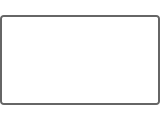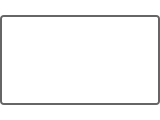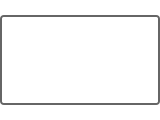...
Name: Edit the zone name.
Type: Use the dropdown list to change the zone type. The options in this list may be limited by the capabilities of the player, as well as media types that you have already added to the zone playlist. The various zone types are described in more detail below.
Size: Define the pixel Width and Height of the zone (applicable to visible zones only).
Position: Define the position of the zone by specifying the X and Y coordinates of the top-left corner of the zone (applicable to visible zones only).
...
Zone Types
When displaying videos and/or images there are three zone types that users must consider:
Video or Image
Video
...
Video Mode: Specify how videos will be scaled to fit in the zone. This setting only has an effect if the video and the zone are different sizes.
Stretch to Fill: Stretches the video to fill the zone without maintaining the aspect ratio. The video will appear stretched or squashed if the aspect ratios of the video and zone do not match. Note that in some early versions, this video mode setting was called “Scale to Fill”.
Scale to Fit: Centers the video and adds black borders on the top and bottom. The aspect ratio is maintained.
Scale to Fill: Centers the video and fills the zone. The aspect ratio is maintained, so the video may be cropped if required. Note that in some early versions, this video mode setting was called “Fill Screen and Centered”.
The Stretch to Fill and Scale to Fit options will not remove letterboxing if it's part of the video file.
...
Image Mode: Specify how images will be scaled to fit in the zone. This setting has no effect if the image and the zone are the same size.
...
Image
Upon first glance, these types may seem somewhat confusing. If one wants to add a video to a zone, for example, should the zone type be “Video or Image”, Video, or does it not matter?
With BrightSign players, graphics elements (e.g., videos, images, HTML, etc.) are rendered on “planes”. Players have a single Graphics Plane where images can be rendered as well as a limited number of Video Planes where videos and images can be rendered.
The Graphics Plane on most BrightSign players is limited to HD. When the Output Resolution of a presentation is set to a resolution higher than HD and an image with a higher-than-HD resolution is placed on the Graphics Plane , graphics upscaling must be employed to display the image which can result in a reduction in visual quality. To get around these limitations of the graphics plane, a video plane can be used to display an image at higher-than-HD resolutions. However, this takes away one of the available video planes.
Another consideration is that the Graphics Plane can render multiple graphics elements simultaneously while a Video Plane can only play one video at a time. Since these resources need to be managed, we have zone types with limitations on the number of zones of each type you can create. These limits are driven by the hardware capabilities of the particular player the presentation is being created for.
The “Video or Image” type makes it easier to transition between graphics states and video states without also needing zone manipulation because the autorun generated by BrightAuthor:connected automatically takes care of this complexity behind the scenes for this zone type.
Video or Image Zone
Video or Image zones allow you to display images, video, and HTML as well as play audio files.
Video/Image Modes
When displaying videos and images, a number of “modes” exist which dictate how the video or image will be positioned and/or scaled/stretched.
Centered
too large
Centers the video or image without scaling. This may result in cropping if the image islarger than the zone.
Scale to Fit
: Scales the image
The image is displayed as large as possible while keeping the correct aspect ratio
The video or image is scaled (the aspect ratio is maintained) to fit the zone.No cropping of the image occurs and black borders are added as necessary.
Scale to Fill
: Scales the image to completely fill the zone while maintaining
.Stretch to Fill: Scales the image to
The video or image is scaled (the aspect ratiois maintained) to completely fill the zone
without maintaining the aspect ratio.Audio Output: Configure audio outputs for the zone.
Analog Stereo: Check this box to enable audio output via the 3.5mm audio connector (or USB Type C connector on the LS423/LS424).
HDMI: Check this box to enable audio output via the HDMI® connector. If your device has multiple HDMI outputs, the corresponding number of HDMI boxes will appear, numbered as HDMI1, HDMI2, etc.
Pass through: Supplies the un-decoded audio signal through the HDMI connector. Use this option if the source audio codec (for example, AC3 Dolby Digital) cannot be decoded by the BrightSign player and is being decoded on an external device.
Stereo: Supplies the decoded audio signal through the HDMI connector.
SPDIF: Check this box to enable audio output via the SPDIF connector.
Pass through: Supplies the un-decoded audio signal through the SPDIF connector. Use this option if the source audio codec (for example, AC3 Dolby Digital) cannot be decoded by the BrightSign player and is being decoded on an external device.
Stereo: Supplies the decoded audio signal through the SPDIF connector.
Initial Video Volume: Set the initial volume for video files (0-100).
Initial Audio Volume: Set the initial volume for audio files (0-100).
Minimum Volume: Set the minimum volume for the zone (0-100).
Maximum Volume: Set the maximum volume for the zone (0-100).
The Maximum Volume setting will be overridden by other volume settings in a presentation, including the Initial Volume setting for the zone and volume commands attached to events or states.
Audio Mixing: Choose the mixing of the audio output:
Stereo: Outputs both left and right audio signals.
Left: Outputs the left audio signal only.
Right: Outputs the right audio signal only.
Video
Video zones allow you to display video files, video streams, or HDMI input.
Video Mode: Specify how videos will be scaled to fit in the zone. This setting has no effect if the video and the zone are the same size.
Scale to Fill: Scales the video to fill the zone without maintaining the aspect ratio. The video will. The image is cropped as necessary.
Stretch to Fill
video
The video or image is stretched (if the aspect ratio of the image differs from that of the zone, the aspect ratio of the image will not be maintained) to fill the zone. The image may appear stretched or squashed if the aspect ratios of theimage and zone do not match.
Letterboxed and Centered: Centers the video and adds black borders on the top and bottom. The aspect ratio is maintained.
Fill Screen and Centered: Centers the video and fills the zone. The aspect ratio is maintained, so the video may be cropped if required.
...
| Info |
|---|
The Stretch to Fill and Scale to Fit options will not remove letterboxing if it's part of the video file. |
...
These animated gifs help visualize the different modes:
Modes for Videos and Images | |||
Centered | Scale to Fit | Scale to Fill | Stretch to Fill |
| |||
Audio Output
Audio settings for this zone type are as follows:
Audio Output: Configure audio outputs for the zone.
Analog Stereo: Check this box to enable audio output via the 3.5mm audio connector (or USB Type C connector on the LS423/LS424).
HDMI: Check this box to enable audio output via the HDMI® connector. If If your device has multiple HDMI outputs, the corresponding number of HDMI boxes will appear, numbered as HDMI1, HDMI2, etc.
PCM: Supplies the decoded audio signal through the HDMI connector.
Pass through: Supplies the un-decoded audio signal through the HDMI connector. Use Use this option if the source audio codec (for example, AC3 Dolby Digital) cannot be decoded by the BrightSign player and is being decoded on an external device.
Stereo: Supplies the decoded audio signal through the HDMI connector.
SPDIF: Check this box to enable audio output via the SPDIF connector.
PCM: Supplies the decoded audio signal through the SPDIF connector.
Pass through: Supplies the un-decoded audio signal through the SPDIF connector. Use this option if the source audio codec (for example, AC3 Dolby Digital) cannot be decoded by the BrightSign player and is being decoded on an external device.
Stereo: Supplies the decoded audio signal through the SPDIF connector.
Initial Video Volume: Set the initial volume for video files (0-100).
Initial Audio Volume: Set the initial volume for audio files (0-100).
Minimum Volume: Set the minimum volume for the zone (0-100).
Maximum Volume: Set the maximum volume for the zone (0-100).
...
Audio Mixing: Choose the mixing of the audio output:
Stereo: Outputs both left and right audio signals.
Left: Outputs the left audio signal only.
Right: Outputs the right audio signal only.
Video Zone
Video zones allow you to display video files, video streams, or HDMI input. Applicable settings are similar to those described for “Video or Image” zone above.
Image Zone
Image zones allow you to display images and HTML. Use the Image Mode dropdown list to determine how images will be displayed in the zone (this setting has Applicable settings are similar to those described for “Video or Image” zone above. Note that setting the Image Mode will have no effect if the image and the zone are the same size):
...
.
...
Scale to Fit: Scales the image to fit the zone. The image is displayed as large as possible while keeping the correct aspect ratio.
...
Scale to Fill and Crop: Scales the image to completely fill the zone while maintaining the aspect ratio.
...
Scale to Fill: Scales the image to fill the zone without maintaining the aspect ratio.
...
Audio Zone
Audio zones allow you to play audio files and streaming audio.
...
| Widget Connector | ||||||
|---|---|---|---|---|---|---|
|
Audio output settings are similar to those described for “Video or Image” zone above.
| Note |
|---|
Attempting to play AC3 audio using a BrightSign player will fail if PCM is enabled and AC3 audio is not enabled. |
Audio Output: Configure audio outputs for the zone.
Analog Stereo: Check this box to enable audio output via the 3.5mm audio connector (or USB Type C connector on the LS423/LS424).
HDMI: Check this box to enable audio output via the HDMI connector.
PCM: Supplies the decoded audio signal through the HDMI connector.
Passthrough: Supplies the un-decoded audio signal through the HDMI connector. Use this option if the source audio codec (for example, AC3 Dolby Digital) cannot be decoded by the BrightSign player and is being decoded on an external device.
SPDIF: Check this box to enable audio output via SPDIF.
PCM: Supplies the decoded audio signal through the SPDIF connector.
Passthrough: Supplies the un-decoded audio signal through the SPDIF connector. Use this option if the source audio codec (for example, AC3 Dolby Digital) cannot be decoded by the BrightSign player and is being decoded on an external device.
Initial Audio Volume: Set the initial volume for audio files (0-100).
Minimum Volume: Set the minimum volume for the zone (0-100).
Maximum Volume: Set the maximum volume for the zone (0-100).
The Maximum Volume setting will be overridden by other volume settings in a presentation, including the Initial Volume setting for the zone and volume commands attached to events or states.
Audio Mixing: Choose the mixing of the audio output:
Stereo: Outputs both left and right audio signals.
Left: Outputs the left audio signal only.
Right: Outputs the right audio signal only.
...
Enhanced Audio Zone
Enhanced Audio zones provide similar functionality Audio zones, but allow cross-fading between audio files in the playlist: Fading occurs from silence at the beginning of the audio playlist and to silence at the end of the audio playlist, while cross-fading occurs between audio files.
Use the Fade property to specify the duration of cross-fading between audio files. This setting also affects the fade-in and fade-out durations.
...
Ticker Zone
Ticker zones allow you to display RSS feeds or pre-defined text strings.
...
Foreground text color: Select a color for text in the zone.
Background text color: Select a color for the text background in the zone.
Background bitmap: Check the box to display an image as the text background. You will be prompted to select an image from your BSN Content Cloud library or your local machine (depending on the Storage Selector setting).
Stretch to Fit: Check this box if you want to stretch the image to fill the zone.
Font: Select the font type for displaying text in the zone.
System Font: Displays text using the default Linux font.
BSN Font: Displays text using a custom font stored on your BSN Content Cloud network. You can use any TrueType font. This option is available when the Storage Selector is set to BSN.Cloud Content.
Local Font: Displays text using a custom font stored on your local machine. You can use any TrueType font. This option is available when the Storage Selector is set to Local Content.
Safe Text: Define the dimensions of the text region in the zone.
Clock Zone
Clock zones allow you to display the date or time.
Rotation: Specify the rotation of text in the zone.
Foreground text color: Select a color for text in the zone.
Background text color: Select a color for the text background in the zone.
Background bitmap: Check the box to display an image as the text background. You will be prompted to select an image from your BSN Content Cloud library or your local machine (depending on the Storage Selector setting).
Stretch to Fit: Check this box if you want to stretch the image to fill the zone.
Font: Select the font type for displaying text in the zone.
System Font: Displays text using the default Linux font.
BSN Font: Displays text using a custom font stored on your BSN Content Cloud network. You can use any TrueType font. This option is available when the Storage Selector is set to BSN.cloud Content.
Local Font: Displays text using a custom font stored on your local machine. You can use any TrueType font. This option is available when the Storage Selector is set to Local Content.
Safe Text: Define the dimensions of the text region in the zone.
Background Image Zone
The Background Image zone allows you to place an image or media feed in the background of your presentation. All other zones appear on top of this zone.
The Background Image zone consumes a video decoder on the BrightSign player. If the player model supports two video zones (e.g. XTx44, XDx34), it can support one Background Image zone and one video zone, while single-video models (e.g. HDx24, LS424) do not support both a video zone and Background Image zone simultaneously.
| Tip |
|---|
If you want a background color for your presentation, change the Background Color in the Presentation Settings pane. |
Control Zone
An This is an invisible zone that is used to control other zones. A zone can be converted to a Control Zone from another zone type.
...



